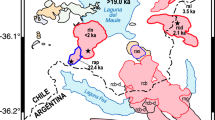Abstract
Four volcanic units have been distinguished on the islanf of Fayal. In order of decreasing age, these are:
-
the eastern rift, and products of the activity preceding the collapse of the caldera visible at the summit of the stratovolcano, characterized by an alkaline series: basalt-hawaiite-mugearite-trachyte;
-
the products of the explosive and postcaldera activity where only evolved lavas occur (benmoreites and trachytes);
-
the recent basaltic activity of the Horta region;
-
the western fissural activity — recent and historical.
The two last units are characterized by exclusively basaltic, frequently picritic, eruptions.
The lava groups cannot be distinguished by chemical criteria and have thus been treated as a single suite.
Ninety samples have been analysed by X-ray fluorescence, and the mineralogy of 6 representative specimens has been determined by microprobe. The data were used to work out the evolution of the lava. The series is shown to have been produced by crystal fractionation under moderate water pressure from an alkali basalt. Moderate fractionation of amphibole during the last stages allow the liquids to remain weakly undersaturated from initial basalts until final trachytes.
Mineralogical and chemical diversity between the most evolved lavas, benmoreites and trachytes, is an evidence of the strong influence ofpH2O and/orfO2 on the composition of such residua.
Resume
Quatre unités volcaniques sont distinguées dans l’île de Fayal:
-
le rift Est, et l’activité anté caldeira du stratovolcan, caractérisé par une série alcaline: basalte-hawaite-mugéatite-trachyte.
-
L’activité explosive et post caldeira, caractérisée par des laves évoluées (benmorites et trachytes).
-
L’activité basaltique récente de la région de Horta.
-
L’activité fissurale ouest, récente et historique.
Ceux deux dernières unités sont caractérisées par des éruptions exclusivement basaltiques, souvent picritiques. Ces ensembles de laves constituent des séries magmatiques que des critères chimiques ne permettent pas de distinguer. L’analyse d’une vingtaine d’échantillons, par fluorescence X, et l’étude minéralogique par microanalyse électronique de six roches représentant les types pétrographiques principaux, permet de préciser le processus de l’évolution de ces laves: cristallisation fractionnée sous pression modérée de H2O à partir d’un magma alcalin, faible fractionnement d’amphibole en fin de série permettant que les liquides demeurent faiblement sous-saturés depuis les basaltes jusqu’aux trachytes.
Une certaine dispersion minéralogique et chimique au niveau des termes les plus évolués: benmoreïtes et trachytes, souligne la grande sensibilité de ces produits de fin de différentiation à l’influence depH2O oufO2.
Similar content being viewed by others
Bibliographie
Baker, I., 1969,Petrology of Volcanic Rocks of Saint-Helena Island, South Atlantic. Geol. Soc. Am. Bull.,80, p. 1283–1310.
Banghar, A. R. andSykes L. R., 1969,Focal Mechanisms of Earthquakes in the Indian Ocean and Adjacent Region. Journ. Geophys. Res.,74, p. 632–649.
Berthois, L., 1953,Contribution à l’étude lithologique de l’Archipel des Açores Comm. Soc. Geol. Portugal,34, p. 1–195.
Bizouard, H., etDi Paola, G. M., 1978,Mineralogy of Tullu Moje Active Volcanic Area (Arussi, Ethiopian Rift Valley). In:Petrology and Geochemistry of Continental Rifts, E.R. Neumann and B.I. Ramberg, p. 87–100.
Buddington, A. F. andLindsley, D. H., 1964,Iron-Titanium Oxides Minerals and Synthetic Equivalents. Jour. Petrol.,5, p. 310–357.
Carmichael, I. S. E. andNicholls J. 1967,Iron-Titanium Oxides and Oxygen Fugacity in Volcanic Rocks. Jour. Geophys. Res.,72, p. 4665–4687.
Dunne, J. C., 1941,Volcanology of the Tristan da Cunha Group. Results Norvegian Science Expedition to Tristan da Cunha, 1937–1938. Oslo, Norske Vudenskaps Akademi,,12, p. 108–227.
Ferrara, G. andTreuil, M., 1974,Petrological Implications of Trace Element and Sr Isotope Distribution in Basalt-Pantellerite Series. Bull. Volcanol.,38–3, p. 548–574.
Ferraud, G., 1977,Contribution à la datation du volcanisme de l’Archipel des Açores par la méthode K-Ar. Conséquences géodynamiques. Thèse d’état, Université de Paris.
Krause, D. C. andWatkins, N. D., 1970,North Atlantic Crustal Genesis in the Vicinity of the Azores. Geophys. J. R. Astr. Soc.,19, p. 261–283.
Kushiro, I. 1960,Si-Al Relations in Clinopyroxene from Igneous Rocks. Am. Jour. Sci.,258, p. 548–554.
Laughton, A. S., 1975,Tectonic Evolution of the Northeast Atlantic Ocean; a Review. Norges geologiske unders Ø kelse,316, p. 169–193.
----- andWhistmarsk, R. B., 1974,The Azores Gilbraltar Plate Boundary in Geodynamics of Island and the North Atlantic. Kristjansson ed., p. 63–81.
Le Bas, M. J., 1962,The Role of Aluminium in Igneous Clinopyroxene with Relation to Their Parentage. Am. Journ. Sci.,260, p. 267–288.
Le Maitre, R. W., 1962,Petrology of Volcanic Rocks, Gough Island, Geol. Soc. Am. Bull.,11, n. 73, p. 1311–1338.
Macdonald, G. A. andKatsura, T., 1964,Chemical Analyses of hawaian Lavas. Journ. Petrol.,5, n. 1, p. 82–133.
Machado, F., 1959,Submarine Pits of the Azores Plateau. Bull. Volcanol.,21, p. 109–125.
—————, 1969, ptSobre a tectonica de Atlantico Norte a Oeste de Portugal. Rev. Fac. Cien. Lisbon, 2a, ser. C.,16, p. 1–14.
Mac Kenzie, D. P., 1970,Plate Tectonics of the Mediterranean Region. Nature, London,226,, p. 239–243.
Maury, R. C., 1976,Contamination (par l’encaissant et les enclaves) et cristallisation fractionnée de séries volcaniques alcalines continentales (Massif-Central) et océanique (Pacifique Central): l’origine des laves acides. Thèse d’état, Orsay.
Schmincke, H. U., 1973,Magmatique Evolution and Tectonic Regime in the Canary, Madeira and Azores Island Group. Geol. Soc. Am. Bull.,84, p. 633–648.
Torre De Assuncao, C. F., 1959,Contribuçao para a petrografia des productos emitidos pelo volcano de Capelinhs (Faïal). Sev. Geol. Port. Mem.,4, p. 57–64.
————— andCanilho, M. H., 1970,Notas sobre petrografia comparada das ilhas Atlanticas. Lisboa. Univ. Fac. Cien. Mat. e Lab. Minerale, Geol. Bol.II, p. 305–342.
Wright, T. L. andDoherty, P. C., 1970,A linear programming and Least Squares Computer Method for Solving Petrologic Mixing Problem. Mineral Distribution Program, MOD II, Bull. Soc. Geol. Am., p. 1995–2007.
Zhyslzewski, G. et Al., 1959,Carta geologa de Portugal, Noticia Explicativa de Folha de Faïal.
Author information
Authors and Affiliations
Rights and permissions
About this article
Cite this article
Metrich, N., Bizouard, H. & Varet, J. Pétrologie de la Série Volcanique de l’île de Fayal (Açores). Bull Volcanol 44, 71–93 (1981). https://doi.org/10.1007/BF02598190
Received:
Revised:
Accepted:
Issue Date:
DOI: https://doi.org/10.1007/BF02598190




